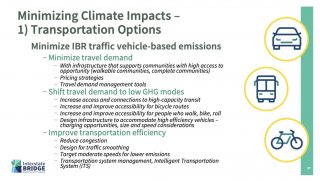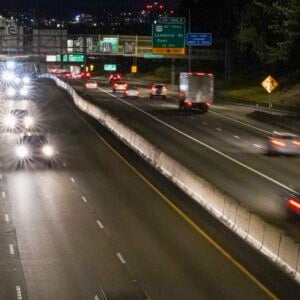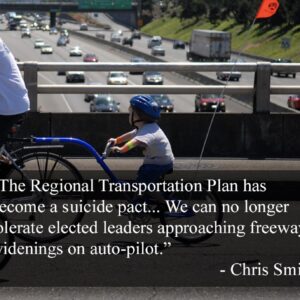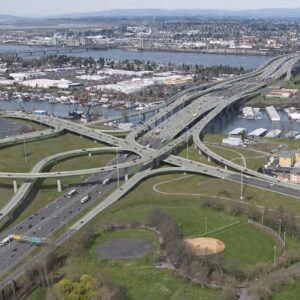
Will the Columbia River Crossing project’s multibillion dollar successor fully integrate climate change into its design and construction? Or will climate change merely be a box that is checked on the way to a wider I-5 that encourages more driving and more emissions? That question took center stage at the July meeting of the Interstate Bridge Replacement project’s Executive Steering Group.
“If we’re just not increasing it, that’s not the same as reducing it.”
— Jo Ann Hardesty, Portland city commissioner
Sarah Oglier, the Principal Climate Officer for the project (which is in many ways a reboot of the CRC), presented the regional elected officials who make up the ESG with the four elements the program is placing in the ‘Climate Framework’. As you can see the in slide from Oglier’s presentation, almost all of the climate-related material focused on “minimizing” emissions
Metro Council President Lynn Peterson pushed strongest against that framing. “Minimizing isn’t good enough,” she said at the meeting. “Severely reducing is how this project is going to have to think about it.” Commissioner Jo Ann Hardesty also echoed those comments: “If we’re just not increasing it, that’s not the same as reducing it.”
Advertisement

Peterson’s comments follow a chorus of concerns raised about the project by her fellow councilors during a Metro work session in late May.
At that meeting, Metro Councilor Shirley Craddick said she sees the inclusion of climate change and bicycle and pedestrian safety in the project’s values as pushing the design to have a “much smaller footprint” than the Columbia River Crossing. Juan Carlos González, after referring to state DOTs as “black boxes of process”, said Metro can’t invest in infrastructure that “increases lanes to a point where it’s just not up to par with our regional plan.” And Mary Nolan, focusing on what she called “climate stewardship”, said she wants to see more than “weak language” around climate change mitigation. “At a minimum it should say ‘reduce greenhouse gases proportional to the billions of dollars we’re investing, potentially, in this project’,” she said.
[RELATED: Opinion: On cognitive dissonance and climate change in Cascadia]
At the July 15th ESG meeting, Commissioner Hardesty returned to an issue she’s raised repeatedly in the past; congestion pricing. “For me, I think the biggest driver in the climate impact will be congestion pricing and how that program is implemented,” she said. She pushed for more specifics on how a “climate justice lens” could be used to produce equitable outcomes and not simply shift the burden of added tolling onto already overburdened communities.
“The science of [induced demand] is unclear where you already have a corridor that’s been in use for years and years.”
— Greg Johnson, IBR Administrator
An op-ed last week by the editorial board at The Columbian called for a strong climate framework with the project, then turned around and noted that “the biggest emissions factor of the current bridge is the congestion it creates. Free-flowing traffic that allows motorists to smoothly move from one place to another will reduce travel times and help limit emissions.” Of course this completely sidesteps the issue of how an expanded I-5 across the Columbia could encourage more trips and undermine a shift to more sustainable modes that all adjacent governments say they’re trying to encourage.
Interstate Bridge Replacement Program Administrator Greg Johnson, in a forthcoming interview with BikePortland, pushed back on the idea that induced demand was a significant consideration for the I-5 project. “The science of it is unclear where you already have a corridor that’s been in use for years and years,” he said. “If we were building a new corridor, induced demand would be tremendously high on the list.” Johnson said the addition of auxiliary lanes, like the ones ODOT is currently advocating for in the Rose Quarter, will turn I-5 across the Columbia into “more of a modern structure going into the future,” but suggested that adding lanes won’t significantly impact demand for the corridor.
The project’s timeline calls for all of the aspects of the projects, including the number of auxiliary lanes and whether the project will include light rail or bus rapid transit (BRT), to be finalized by next spring — an aggressive timeline related to a desire to start construction in 2025. The climate impact of any design is sure to be fiercely debated, but it should be pretty clear before that point if things are veering as wildly off-track as many anticipate.
— Ryan Packer – ryan@theurbanist.org
— Get our headlines delivered to your inbox.
— Support this independent community media outlet with a one-time contribution or monthly subscription.





I love the ironic symbolism of the IBR Climate diagram – it looks just like a highway clover leaf interchange. Accidental – I’m very sure it isn’t.
And did anyone notice how friendly the car-face is in the slide? It’s a happy little car!
2021 ‘car faces’ are anything but friendly, they are downright disturbing!!
*sigh*
I can already tell that the interview with Greg Johnson is going to give me an aneurysm…
“The science of it is unclear…” Just shameless charlatanry. Not only is the research decisive, but like, just spend 5 minutes talking with some Portlanders about why they don’t live in quiet, cheap Vancouver. Everyone I’ve ever talked with about it cites the bridge congestion as the first or second top impediment. Remove that impediment, and people aren’t going to move across the river in droves? Please someone cut this climate arsonist a bigger fig leaf.
I think the problem is that they don’t “believe” in induced demand. It’s impossible to deny, because it’s logical, and the evidence is clear. But if someone believes that “cars are freedom”, they must also then support policies that allow for unfettered car access to all parts of the country via free-flowing roads, at all times of day. Induced demand is an affront to this belief, because it acknowledges that capacity limitations will alter human behavior.
Gregg Johnson’s claim that the science of induced demand isn’t settled, and that it somehow doesn’t apply in existing corridors is a blatant and insulting lie. Induced demand applies to exactly the situation we’re facing on I-5, with a dense urban area with plenty of latent demand ready to occupy expanded road capacity. Bike Portland shouldn’t allow Johnson to make any such claim uncontroverted, anymore than it would publish a climate change or holocaust denier. Make Johnson or any other shills for this project present some actual evidence for their self-serving claims.
Here, by the way, are the links to literature. https://cityobservatory.org/the-fundamental-global-law-of-road-congestion/
The science is so well-established that we now have calculators, such as those developed by UC Davis and the Rocky Mountain Institute that tell us just how much more traffic, pollution and greenhouse gases an additional lane mile of freeway will create. They’re calibrated exactly for added road capacity in dense urban areas.
https://ncst.ucdavis.edu/research-product/induced-travel-calculator
As Homer Simpson would say, DOH (Bart would have a cow about this…) And Lisa would certainly not be silent either!!!
Let me guess…Greg Johnson is an Engineer? ‘civil’, ‘traffic’ whatever. We need to take control back from the ‘engineers’, that’s the only way we will ever overcome the forces behind ‘climate change’ etc….and don’t just hire some NGO ladder climber in a powerless position either, that’s just pure BS!
How about our climate goals be forced on to our businesses? We make them have a percentage of their workers work from home. Then, people can live where they can afford to and the bridge can do whatever it needs to. Sounds much but than this silly induced demand that seeks to charge people to drive. Clearly, lane diets, rose lanes, biking, transit, and scootering aren’t doing the job. As far as blaming people for living in Washington, I’m generally curious how many portlanders drive to Washington for their recreational goals? Probably a higher number than would like to admit.
Are you really equating an occasional jaunt to Washington for recreation with a daily commute into Portland? As for your proposal, it’s an interesting concept,. But my guess is that it, too, would induce additional demand–it’d free up road capacity that would then be filled with additional uses of the roadway (new commuters, other traffic). But as for a strategy to avoid adding road capacity, maybe it could help.
Gary, it’s simple, we need more office workers at home. They need it as well. The city talks about home much money you save by not driving, think about how much more time you’ll get back by not. Same goes for the bus. I could use a few less moments on the bus. Not that I ride it anyways, but the fewer the moments, the better. As far as cycling, it’s the one option where I feel like I’m winning since it helps me in a variety of ways. Interesting concept on some extra induced demand with my idea, Maybe more companies need to move out of Portland (would be cost effective) to Vancouver to better support their work force. For the equity aspect, less single car users means those who do have to go downtown would have faster commute times, especially those in east county. This idea is that of the Rose Lane vibe.
As for recreation, one doesn’t need to look far for parking restricted places.. to name a few Lower Lewis, ape caves, dog mountain, and naked falls. Yeah, it’s not commuter level but it exists and an issue in those areas.
I can use our family as an example: we recreate a ton. Hiking, cycling, climbing, boating, etc. We cross the bridge into Washington maybe once a month. I also go over every 8 weeks to donate blood. This absolutely pales in comparison to my coworkers who drive over 5 days per week to come into the office, and usually 1-2 times each weekend to recreate and shop. Turns out that most of the regional destinations are on the Oregon side.
Go ride your bike on the I-5 or I-205 bridges on a Saturday or Sunday morning, and you’ll see the mix of license plates seem to represent one state more than the other.
“The science of it is unclear where you already have a corridor that’s been in use for years and years,”
Are you kidding me?! Nearly every infamous example in recent years of induced demand have been an existing freeway doubling in number of lanes only to fill up immediately with additional traffic. There was that one in Texas recently, some in California…the list goes on and on. People do whatever Google Maps tells them, and if there’s additional capacity on the I-5 bridge it will induce people in Clark County to take more discretionary, unnecessary trips across the river, and will also induce more people to live in Clark County and work in Oregon, or vice versa.
What adding freeway lanes does is make the pipe bigger, allowing more throughput. But it doesn’t solve congestion. It’s just more volume of traffic moving very slowly rather than a smaller volume of traffic moving very slowly.
For most of the 20th century this was the explicit goal of freeway construction. It wasn’t about safety or congestion. The primary purpose was to move more people into downtowns and other major employment centers. Nobody pretended otherwise back in the 50s, 60s, 70s. It’s only been in recent decades as people have soured on freeways that state DOTs have started trying to argue freeway expansion will solve congestion or improve safety. Don’t believe it. It’s all about capacity and always has been.
To be fair, there are some very smart transportation planners and engineers who actually do think that merges are dangerous and cause congestion, and that auxiliary lanes are the solution to everything. And I actually do think a “real” auxiliary lane can be an improvement. But by “real” I mean connecting one on-ramp to the next off-ramp. As soon as you start connecting an on-ramp to an off-ramp three or four interchanges away, and then connecting the middle ones to each other, and so one, and are adding two or three auxiliary lanes? To quote our President, “Come on, man. Don’t give me that malarkey.” That’s just a freeway widening project. Once you’re connecting one interchange to another one several interchanges away, that lane is long enough to be considered a through lane because a high number of trips will simply use that lane for its entire length.
> “the biggest emissions factor of the current bridge is the congestion it creates.”
Hey ODOT: EVs would solve this problem for you.
But building giant concrete structures will by definition create GHG emissions (so long as the recipe for concrete involves cement, which emits CO2 heavily as an unavoildable chemical reaction during its creation). So until we have non-cement-based ways of building these massive structures, we need to avoid building them. And we can do that with a seismic retrofit in this case. (How do we get transit on the bridges you ask? Easy – look at the earliest pictures of the bridge when it was built. It had rail on it then.)